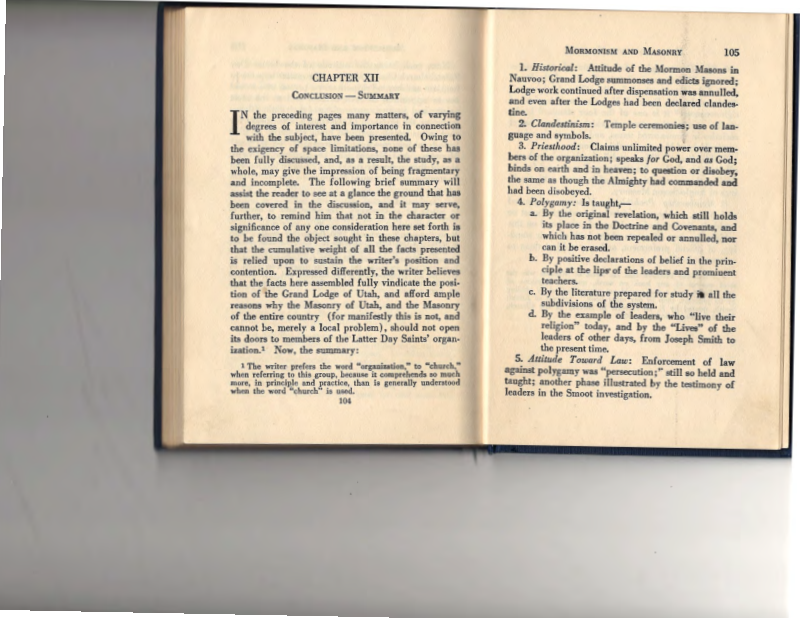Samuel H. Goodwin discusses the relationship between the Mormon Church and Freemasonry, highlighting historical attitudes, clandestine practices, theological differences, and prohibitions on membership.
- Type
- Book
- Source
- Samuel H. Goodwin Non-LDS
- Hearsay
- Secondary
- Reference
Samuel H. Goodwin, Mormonism and Masonry (Washington, D.C.: The Masonic Service Association of the United States, 1924), 104–106
- Scribe/Publisher
- Samuel H. Goodwin
- People
- Samuel H. Goodwin
- Audience
- Reading Public
- Transcription
CHAPTER XII
Conclusion — Summary
IN the preceding pages many matters, of varying degrees of interest and importance in connection with the subject, have been presented. Owing to the exigency of space, limitations, none of these has been fully discussed and, as a result, the study, as a whole, may give the impression of being fragmentary and incomplete. The following brief summary will assist the reader to see at a glance the ground that has been covered in the discussion, and it may serve, further, to remind him that not in the character or significance of any one consideration here set forth is to be found the object sought in these chapters, but that the cumulative weight of all the facts presented is relied upon to sustain the writer's position and contention. Expressed differently, the writer believes that the facts here assembled fully vindicate the position of the Grand Lodge of Utah, and afford ample reasons why the Masonry of Utah, and the Masonry of the entire country (for manifestly this is not, and cannot be, merely a local problem), should not open its doors to members of the Latter Day Saints' organization. Now, the summary:
1. Historical: Attitude of the Mormon Masons in Nauvoo; Grand Lodge summonses and edicts ignored; Lodge work continued after dispensation was annulled, and even after the Lodges had been declared clandestine.
2. Clandestinism: Temple ceremonies; use of language and symbols.
3. Priesthood: Claims unlimited power over members of the organization; speaks for God, and as God; binds on earth and in heaven; to question or disobey, the same as though the Almighty had commanded and had been disobeyed.
4. Polygamy: Is taught—
a. By the original revelation, which still holds its place in the Doctrine and Covenants, and which has not been repealed or annulled, nor can it be erased.
b. By positive declarations of belief in the principle at the lips of the leaders and prominent teachers.
c. By the literature prepared for study in all the subdivisions of the system.
d. By the example of leaders, who "live their religion" today, and by the "Lives" of the leaders of other days, from Joseph Smith to the present time.
5. Attitude Toward Law: Enforcement of law against polygamy was “persecution;” still so held and taught; another phase illustrated by the testimony of leaders in the Smoot investigation.
6. The Great Light: Substitution of pronouncements of “living oracles” (specifically, of the President of the organization) for the Bible; further, it is displaced by the Book of Mormon, as a teacher of righteousness; it is one of the four standard books of the organization, two of which condemn secret societies in unmeasured terms, and trace their origin, particularly of Masonry, to the evil one.
7. The Deity: "Many gods" clearly and emphatically taught; God an "exalted man;" male and female deities; these conceptions out of harmony with teachings of Anglo-Saxon Masonry.
8. Membership Prohibited: Masonry originated with Satan, and because of its evil tendencies must be avoided; disregard of teachings of priesthood on this subject deprives adherents of the faith of their standing, of official preferment, and may subject them to excommunication.
- Citations in Mormonr Qnas
The B. H. Roberts Foundation is not owned by, operated by, or affiliated with the Church of Jesus Christ of Latter-day Saints.

